Chimney fires are no joke. Each year there are approximately 25,000 chimney fires in the United States. These fires cause over $100 million in property damages and can lead to injury and even death. A fast-burning chimney fire can quickly cause your chimney liner to expand and crack, exposing and igniting combustibles in your home. This can happen in an instant so it’s important to know what causes these fires, how to prevent them, and what you should do if you have one.
With over 17 years of experience providing the great Houston area the highest quality chimney, fire place, and dryer vent services, Lords Chimney has a wealth of chimney wisdom to share with you.
What Is Chimney Creosote?
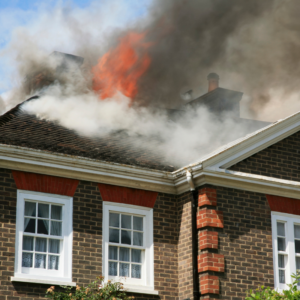 The most common cause of a chimney fire is creosote accumulation in an unclean chimney. When you have a fire in your fireplace, you are causing a chemical reaction. It is this reaction that turns wood to ash and sends byproducts up the chimney. Two of those things that result from these byproducts are soot and creosote. When you see black and sometimes even greasy-looking spots on the masonry in your fireplace, you are looking at soot and creosote.
The most common cause of a chimney fire is creosote accumulation in an unclean chimney. When you have a fire in your fireplace, you are causing a chemical reaction. It is this reaction that turns wood to ash and sends byproducts up the chimney. Two of those things that result from these byproducts are soot and creosote. When you see black and sometimes even greasy-looking spots on the masonry in your fireplace, you are looking at soot and creosote.
Soot needs to be cleaned, but the real danger lies in the creosote. Creosote is a black or brown substance that can be flaky or sticky, tar-like or shiny – and the more you burn, the more creosote can build up. If it is regularly removed, creosote comes off easily. If it is allowed to build up, creosote can harden and glaze, becoming an ever bigger danger to the chimney owner.
Creosote is extremely combustible. It will ignite at 451 degrees. Many fireplace fires will burn at 450 degrees which means that it doesn’t take much to turn that creosote into a burning chimney fire that threatens your chimney, house, and life. Because it is a natural byproduct of burning, creosote is going to accumulate over time, but there are ways to slow its accumulation and drastically lower the risk of fire in your chimney.
5 Ways to Slow Creosote Buildup
What can you do to slow down creosote accumulations?
✓ Use properly dried and well-seasoned wood.
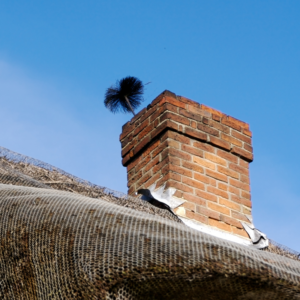 The easiest way to slow the buildup of creosote is to make sure the fuel of your fire burns efficiently. This means that properly dried and seasoned firewood is your best choice when creating that cozy fire. Moisture in your firewood creates an inability to burn completely leaving wasteful byproducts traveling up your chimney and sticking to the walls.
The easiest way to slow the buildup of creosote is to make sure the fuel of your fire burns efficiently. This means that properly dried and seasoned firewood is your best choice when creating that cozy fire. Moisture in your firewood creates an inability to burn completely leaving wasteful byproducts traveling up your chimney and sticking to the walls.
Freshly chopped firewood will usually have around 50% moisture content. It is heavy and sometimes you will even be able to see some green coloring in the wood itself. The firewood you burn should have a moisture content of no more than 25%.
Before burning, do a quick visual and audible inspection of your wood. It should be light in color and light in weight with no visible green coloring. When you knock two pieces together you should hear a clear clunk rather than a low, dull, thud. These visual and audible cues can let you know whether you are going to be quickly adding to your creosote buildup or efficiently burning the safest fuel.
✓ Make sure your chimney’s liner is in good shape.
Your chimney should have a liner on the inside walls that is made to protect the chimney from creosote buildup. Liners improve the airflow and efficiency of your fireplace which means a safer home for you. Make sure your liner is inspected every year.
Our team at Lords Chimney are experts at sizing, installing, and caring for chimney liners. A simple phone call to one of our experts at Lords Chimney is the best way to make sure your liner is doing everything it’s meant to do.
✓ Make sure your chimney has good airflow
Make sure you are taking care to keep that chimney damper open along with any doors that might be on the front of your fireplace. Your chimney was likely installed with a specific airflow in mind. Check the operator’s manual and make sure you’re using your fireplace how it was built to be used.
✓ Invest in regular chimney cleanings
The best way to make sure your chimney is safe is by having a chimney technician from Lords Chimney sweep and inspect it. Our experts are certified, equipped, and trained to get rid of that creosote and leave your chimney clean and ready to use. We are happiest when you are safe and happy. There is simply no better way to keep that creosote at bay.
✓ Know About Debris and Animals
While creosote is the most common instigator of chimney fires it is important to keep an eye out for things in your chimney that just shouldn’t be there. Because it is dry, warm, and protected from wind, an unprotected chimney can quickly collect blowing debris and become home to unwanted animals.
The easiest way to avoid debris and animal homes clogging up your chimney is to make sure that you have a properly fitting chimney cap installed. A chimney cap is great at keeping out unwanted creatures, leaves, sticks, and other rooftop invaders. It also allows air to continue to flow properly. As your go-to chimney experts, Lords Chimney is ready to install the perfect cap protection for your chimney.
Give Our Sweeps a Call Today
Lords Chimney is certified by the Chimney Safety Institute of America (CSIA), and we have established a reputation in our community for providing the most professional chimney services you can find. Your safety is important to us. Call or book online today to schedule an appointment with one of our chimney technicians and get your chimney clean and healthy.
If you’ve ever noticed any gummy-looking black stuff in your chimney, chances are it’s creosote. This dark residue is a byproduct of burning wood and it sticks to the inner walls of chimneys. It can be either flaky, shiny, or sticky.
And since creosote forms through burning wood, it is naturally prone to catching on fire. As such, the Chimney Safety Institute of America (CSIA) highlights its high combustibility as a primary safety concern.
Does Creosote Increase the Risk of a Chimney Fire?
Yes! Creosote is a combustible byproduct that can easily catch fire. And once it ignites, it can quickly spread through the chimney, causing the liner to break down and the masonry to crumble and crack. This means any future fires you light will be more prone to escape the chimney walls and enter your home.
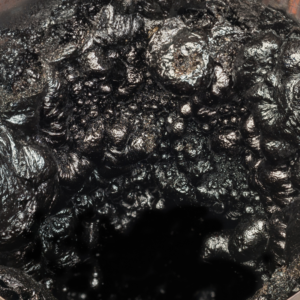 Creosote can also accumulate until it clogs the flue. This blocks the free flow of gases and smoke causing problems with drafting and airflow to develop. This hinders efficiency levels, and it puts you more at risk of being exposed to hazardous fumes, like smoke from your fires or even carbon monoxide – a deadly and extremely hard-to-detect gas.
Creosote can also accumulate until it clogs the flue. This blocks the free flow of gases and smoke causing problems with drafting and airflow to develop. This hinders efficiency levels, and it puts you more at risk of being exposed to hazardous fumes, like smoke from your fires or even carbon monoxide – a deadly and extremely hard-to-detect gas.
Considering the health and safety hazards that creosote poses, regular chimney sweepings become a critical obligation. Professional chimney sweeps have the right equipment to assess any chimney’s condition and address creosote buildup before it becomes a problem.
How To Prevent Creosote Buildup
While creosote isn’t unavoidable, there are ways to effectively reduce accumulation in your flue:
- Schedule Annual Chimney Inspections: It’s important to have a CSIA certified chimney sweep inspect your chimney once per year – before the fall burning season. This is where buildup can be spotted, along with any damages that need to be repaired. Your sweep can also note whether you’ve already experienced a chimney fire.
- Don’t Neglect Sweepings: Regular service is the best way to prevent creosote buildup. If your sweep notes excess creosote deposits during their inspection, be sure to get a follow-up sweeping scheduled as soon as possible. Experts have the proper tools and can remove any buildup in your chimney walls or flue that boosts the chances of experiencing a chimney fire.
- Burn Dry & Well-Seasoned Firewood: Be sure to only burn the correct type of wood in your system. Consider sourcing properly seasoned firewood and make sure it is sufficiently dried out before you toss it in the fireplace. If you put wet, unseasoned wood in your fireplace, you risk producing more residue that will eventually stick to chimney walls, greatly increasing your risk of experiencing a chimney fire.
- Maintain Your Chimney Liner: Ensure that your chimney liner is in good shape and that the chimney is lined correctly. Properly installing a chimney liner improves its performance, but if the liner has been installed incorrectly, it will malfunction and even cause a bigger creosote problem. It can be confusing to determine whether your chimney liner is working correctly, so you it’s always best to rely on the eyes and knowledge of a pro.
- Ensure Proper Chimney Airflow: Whenever you use your fireplace and chimney, be sure the structure gets enough air. Good draft helps fires burn at hotter temperatures, minimizing creosote production in the process. Be sure your damper is open wide enough, took, and get your inspection booked to ensure no blockages are present.
What Are the Signs of a Chimney Fire?
Most chimney fires move slowly and don’t produce a lot of noise, which means you may have had one without noticing. The CSIA identifies the following signs that your chimney could have survived fire before:
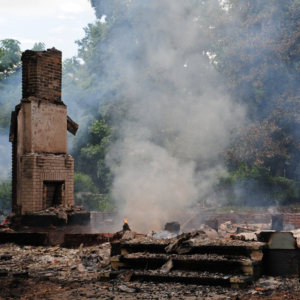 Black or dark-brown byproducts in chimney walls or fireplace
Black or dark-brown byproducts in chimney walls or fireplace- Honeycombed or puffy creosote
- Exterior masonry cracks
- Discoloration in the chimney cap
- Damage to the roofing material due to hot byproducts
- Warped damper metal
- Heat-damaged TV antenna
- Smoke escaping in areas other than the chimney, particularly through tile liners
- Cracked and missing flue tiles
If you do notice that a chimney fire is currently occurring, exit the home immediately and get in touch with your local fire department as soon as possible. In addition, as you are leaving your home, the CSIA suggests closing the door behind you if you can. The goal is to prevent any more air from feeding the flames until the fire department arrives.
Invest in Professional Sweeping Services With Us Today
Even if you believe that your chimney is functioning correctly, there could be hazards hiding away, ready to cause issues. Scheduling a chimney inspection is one way to gain peace of mind, during which we can determine if you need a sweeping.
Creosote is a dangerous byproduct that you might fail to notice immediately. This material is combustible and can cause health and fire hazards in your home. To effectively avoid this issue, we suggest getting in touch with one of our CSIA certified chimney sweeping experts to inspect and clean your chimney. Schedule an inspection today!
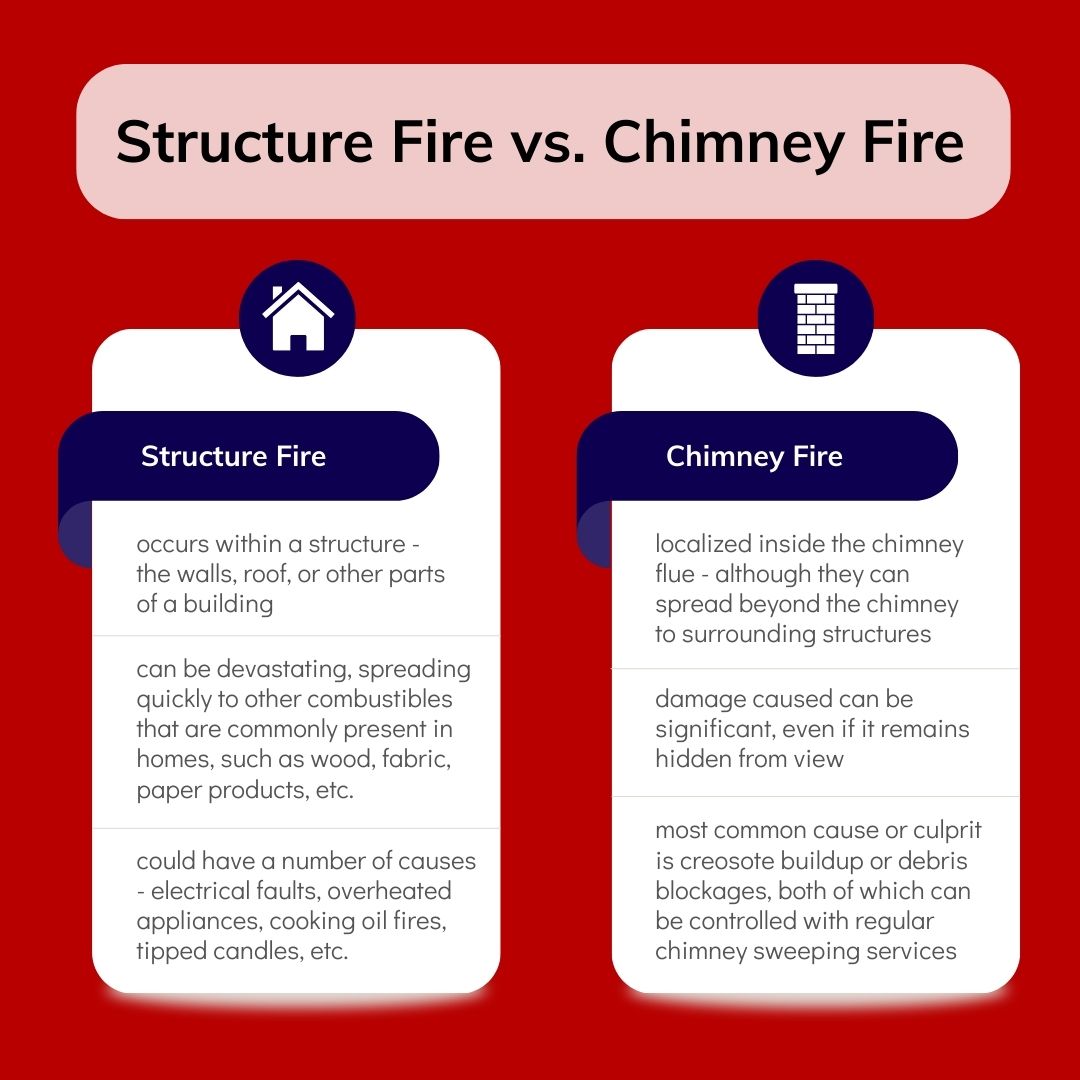

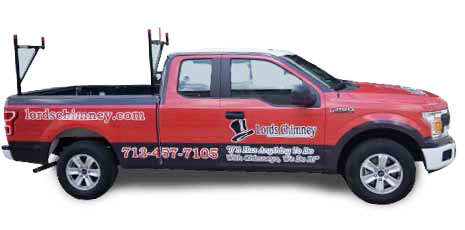
 The most common cause of a chimney fire is creosote accumulation in
The most common cause of a chimney fire is creosote accumulation in  The easiest way to slow the buildup of creosote is to make sure the fuel of your fire burns efficiently. This means that properly dried and seasoned firewood is your best choice when creating that cozy fire. Moisture in your firewood creates an inability to burn completely leaving wasteful byproducts traveling up your chimney and sticking to the walls.
The easiest way to slow the buildup of creosote is to make sure the fuel of your fire burns efficiently. This means that properly dried and seasoned firewood is your best choice when creating that cozy fire. Moisture in your firewood creates an inability to burn completely leaving wasteful byproducts traveling up your chimney and sticking to the walls.  Creosote can also accumulate until it clogs the flue. This blocks the free flow of gases and smoke causing problems with drafting and airflow to develop. This hinders efficiency levels, and it puts you more at risk of being exposed to hazardous fumes, like smoke from your fires or even
Creosote can also accumulate until it clogs the flue. This blocks the free flow of gases and smoke causing problems with drafting and airflow to develop. This hinders efficiency levels, and it puts you more at risk of being exposed to hazardous fumes, like smoke from your fires or even  Black or dark-brown byproducts in chimney walls or fireplace
Black or dark-brown byproducts in chimney walls or fireplace